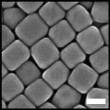Home > Press > Wavelength-Dependent Shapeshifting: Plasmon-Mediated Growth Control
 |
Abstract:
Methods which allow predictable and reproducible control over the shape and defect structures of nanoparticles are a sought-after ideal in research on nanoparticle synthesis. Realising this ideal for silver nanoparticles is one step closer with the discovery that the localised surface plasmon resonance feature observed for nanoscale metals - the collective oscillation of their electrons caused by incident light - can be used to predictably direct the growth of silver nanocrystals.
Wavelength-Dependent Shapeshifting: Plasmon-Mediated Growth Control
Germany | Posted on January 10th, 2013Such plasmon-mediated growth allows control over the size and shape of the crystals by controlling the wavelength of light incident on the sample. The underlying mechanism is based on silver redox chemistry: excitation of the plasmon in an aqueous citrate solution catalyses the reduction of silver ions, the speed of which influences the dominant facets (and hence the shape) of the growing crystals. In this way, longer excitation wavelengths can be applied to produce longer edge lengths. The corresponding oxidation of seed particles causes their dissolution, increasing the bulk concentration of silver ions.
Mirkin and co-workers have refined this technique to generate twinned silver nanocrystals by controlling the defects within the crystal structure. They discovered that irradiation at higher energies increases the number of twin boundaries during growth. By adjusting the wavelength from 400 to 500 nm, bipyramids or cubes with different types of twin boundaries could be selectively produced.
More specifically, longer excitation wavelengths (500 nm) reduce silver ions more slowly, producing monodisperse planar-twinned nanostructures (right bipyramids); shorter excitation wavelengths (400 nm) increase the silver ion reduction rate, increasing the growth speed and hence producing crystals with a higher number of defects, leading to twinned structures. Using the intermediate wavelength of 450 nm, silver nanocubes with multiple twin boundaries could be selectively generated.
This plasmon-mediated shape control could also be extended to longer wavelengths, which were tuned to produce silver nanorods with controllable aspect ratios.
The challenge is now to develop this method for other nanoscale species with plasmon resonances.
####
For more information, please click here
Copyright © Wiley-VCH Materials Science Journals
If you have a comment, please Contact us.Issuers of news releases, not 7th Wave, Inc. or Nanotechnology Now, are solely responsible for the accuracy of the content.
| Related Links |
![]() Link to the original paper on Wiley Online Library:
Link to the original paper on Wiley Online Library:
| Related News Press |
News and information
![]() Researchers develop molecular qubits that communicate at telecom frequencies October 3rd, 2025
Researchers develop molecular qubits that communicate at telecom frequencies October 3rd, 2025
![]() Next-generation quantum communication October 3rd, 2025
Next-generation quantum communication October 3rd, 2025
![]() "Nanoreactor" cage uses visible light for catalytic and ultra-selective cross-cycloadditions October 3rd, 2025
"Nanoreactor" cage uses visible light for catalytic and ultra-selective cross-cycloadditions October 3rd, 2025
![]() Researchers tackle the memory bottleneck stalling quantum computing October 3rd, 2025
Researchers tackle the memory bottleneck stalling quantum computing October 3rd, 2025
Chemistry
![]() "Nanoreactor" cage uses visible light for catalytic and ultra-selective cross-cycloadditions October 3rd, 2025
"Nanoreactor" cage uses visible light for catalytic and ultra-selective cross-cycloadditions October 3rd, 2025
![]() Cambridge chemists discover simple way to build bigger molecules – one carbon at a time June 6th, 2025
Cambridge chemists discover simple way to build bigger molecules – one carbon at a time June 6th, 2025
Discoveries
![]() Researchers develop molecular qubits that communicate at telecom frequencies October 3rd, 2025
Researchers develop molecular qubits that communicate at telecom frequencies October 3rd, 2025
![]() Next-generation quantum communication October 3rd, 2025
Next-generation quantum communication October 3rd, 2025
![]() "Nanoreactor" cage uses visible light for catalytic and ultra-selective cross-cycloadditions October 3rd, 2025
"Nanoreactor" cage uses visible light for catalytic and ultra-selective cross-cycloadditions October 3rd, 2025
Materials/Metamaterials/Magnetoresistance
![]() First real-time observation of two-dimensional melting process: Researchers at Mainz University unveil new insights into magnetic vortex structures August 8th, 2025
First real-time observation of two-dimensional melting process: Researchers at Mainz University unveil new insights into magnetic vortex structures August 8th, 2025
![]() Researchers unveil a groundbreaking clay-based solution to capture carbon dioxide and combat climate change June 6th, 2025
Researchers unveil a groundbreaking clay-based solution to capture carbon dioxide and combat climate change June 6th, 2025
![]() A 1960s idea inspires NBI researchers to study hitherto inaccessible quantum states June 6th, 2025
A 1960s idea inspires NBI researchers to study hitherto inaccessible quantum states June 6th, 2025
![]() Institute for Nanoscience hosts annual proposal planning meeting May 16th, 2025
Institute for Nanoscience hosts annual proposal planning meeting May 16th, 2025
Announcements
![]() Rice membrane extracts lithium from brines with greater speed, less waste October 3rd, 2025
Rice membrane extracts lithium from brines with greater speed, less waste October 3rd, 2025
![]() Researchers develop molecular qubits that communicate at telecom frequencies October 3rd, 2025
Researchers develop molecular qubits that communicate at telecom frequencies October 3rd, 2025
![]() Next-generation quantum communication October 3rd, 2025
Next-generation quantum communication October 3rd, 2025
![]() "Nanoreactor" cage uses visible light for catalytic and ultra-selective cross-cycloadditions October 3rd, 2025
"Nanoreactor" cage uses visible light for catalytic and ultra-selective cross-cycloadditions October 3rd, 2025
|
|
||
|
|
||
| The latest news from around the world, FREE | ||
|
|
||
|
|
||
| Premium Products | ||
|
|
||
|
Only the news you want to read!
Learn More |
||
|
|
||
|
Full-service, expert consulting
Learn More |
||
|
|
||








